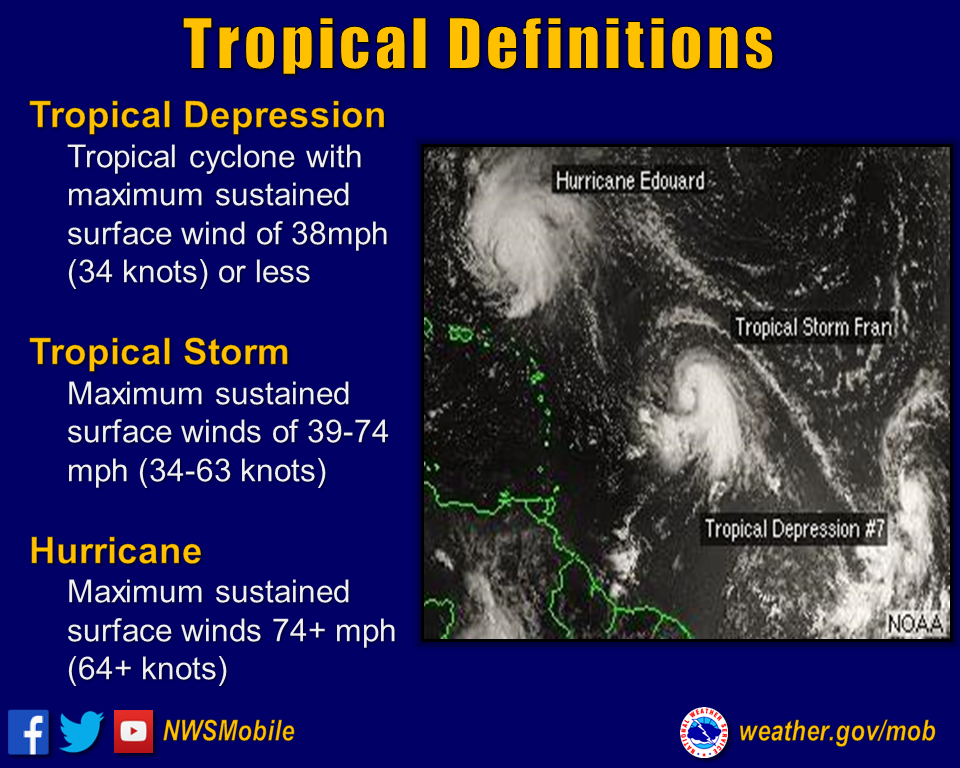Tropical Definitions
Tropical Wave
An inverted trough (an elongated area of relatively low pressure) or cyclonic curvature maximum moving east to west across the tropics. These can lead to the formation of a tropical cyclone. Also known as an easterly wave.
Tropical Disturbance
A tropical weather system with organized convection (generally 100-300 miles in diameter) originating in the tropics or subtropics, having a non-frontal migratory character and maintaining its identity for 24 hours or longer. It may or may not be associated with a detectable perturbation of the wind field.
A tropical cyclone is a low pressure system (not associated with a front) that develops over tropical and sometimes sub-tropical waters and has organized deep convection with a closed wind circulation about a well-defined center.
Extratropical Cyclone
A cyclone (of any intensity) for which the primary energy source is baroclinic (i.e., results from the temperature contrast between warm & cold air masses).
Post-Tropical Cyclone
A cyclone that no longer possesses sufficient tropical characteristics to be considered a tropical cyclone. Post-tropical cyclones can continue to carry heavy rains and high winds. Note: former tropical cyclones that become extratropical and remnant lows are 2 specific classes of post-tropical cyclones.
Remnant Low
A class of post-tropical cyclone that no longer possesses the convective organization required of a tropical cyclone and has maximum sustained winds of less than 34 knots.
Subtropical Cyclone
A non-frontal low pressure system that has characteristics of both tropical and extratropical cyclones. Subtropical cyclones originate over tropical or subtropical waters and have a closed circulation about a well-defined center. In comparison to tropical cyclones, the maximum winds occur relatively far from the center (greater than 60 nautical miles) and have a less symmetric wind field and distribution of convection.
Tropical Depression
A tropical depression is a tropical cyclone that has maximum sustained surface winds (one-minute average) of 38 mph (33 knots) or less.
Tropical Storm
A tropical storm is a tropical cyclone that has maximum sustained surface winds ranging from 39-73 mph (34 to 63 knots).
Hurricane
NOTE: The number of Tropical Storms and Hurricanes increases substantially in August, peaks in mid-September and decreases towards a minimum by early November.
Tropical Storm Watch
A Tropical Storm Watch is issued when Tropical Storm conditions, including winds of 39-73 mph, pose a POSSIBLE threat to a specified coastal area within 48 hours.
Tropical Storm Warning
A Tropical Storm Warning is issued when Tropical Storm conditions, including winds of 39-73 mph, are EXPECTED in a specified coastal area within 36 hours or less.
Hurricane Watch
Hurricane Warning
NOTE: A Hurricane Warning can remain in effect when dangerously high water or a combination of dangerously high water and exceptionally high waves continues…even if the winds have subsided below hurricane intensity.
Eye Wall
An organized band of cumulonimbus clouds immediately surrounding the center of the tropical cyclone.
Storm Surge
An abnormal rise in sea level accompanying a tropical cyclone. This is the difference in height between observed level of the sea surface and the level that would have occurred in the absence of the storm. Storm surge is usually estimated by subtracting the normal or astronomical tide from the observed storm tide.
Storm Tide
The water level rise resulting from the astronomical tide combined with the storm surge.

